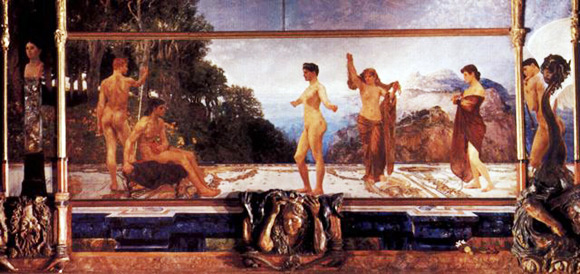Jugement de Pâris
Download PDFThe subject of the Judgment of Paris has been one of the most important in history of arts, liked by elites who see a deep philosophical meaning in it, as well as the people touched by its universal message.
In immemorial times, Paris, young prince of Troy, arbitrated a quarrel between the mother-goddess Hera, the war goddess Athena, and the love goddess, Aphrodite. The three goddesses argued to get a golden apple meant to be given “to the fairest one”, apple thrown by Eris, goddess of discord, to punish them. Each of them made an offer to Paris to bend his judgment : Hera offered domination of Asia and wealth, Athena promised victory in combat, but also beauty and wisdom; as for Aphrodite, she lured him with Helen, the most beautiful woman among mortals. The Judgment of Paris represents this fateful moment when love guides the mortal’s action, and makes him prefer Aphrodite. Under her power, Helen, wed to Menelaus, King of Sparta, falls in love with Paris and flees with him: it is the trigger of the Trojan War, terrible conflict described in the Iliad and the Odyssey.
Love, in its nearly all-mighty power, at the same time wonderful and terrible, is thus the subject of this mythical episode. Placed at the very beginning of the Trojan Cycle, it has a primordial philosophical importance, considering love as the driving force of the world itself.
A myth set in 6th century before our era in the Cypria, the story was however already ancient, known from an oral culture. The power of love, driving the craziest actions, the most terrible jealousy, and the most beautiful dreams, is an immemorial subject that hasn’t stopped surfacing in literature : Paris and Helen are the archetype of the cursed lovers that will be Tristan and Iseult, Romeo and Juliet, and so many others. The rest of the myth contains other archetypes, in particular Eris’s original vexation, without whom the story wouldn’t have happened. By throwing the apple between the three goddesses’ hands, Eris was avenging of not having been invited to a banquet on Mount Olympus… one can recognize in this jealous goddess the evil fairy who will curse the Sleeping Beauty.
In arts, the judgment of Paris has a tremendous success. It is one of the most recurrent subjects of vase painting, confirming its importance in the Antiquity. At the end of the Middle Age, 15th century rediscovers this subject, providing charming versions in which the goddesses are generally dressed in the International Gothic fashion. But it is Renaissance above all that revisits the subject, under the influence of new dogmas. Neoplatonism, a philosophical trend based on a mystic of Eros, is then broadly spreading in Italian Renaissance, in particular under the influence of the Medici. The judgment of Paris is indeed revealing the power of Eros, and represents for Renaissance’s men a mystery understood in Antiquity that they have to seize. Sandro Botticelli, the most connected artist to Neoplatonism, makes a version of it, but it is that of the illustrious Raffaello Sanzio that, known by an engraving by Marco Antonio Raimondi, will be the most influential on the following centuries.
This famous engraving would have been the very first to be so broadly spread. The artist composed the scene after a 3rd century bas-relief preserved in Andrea della Valle antiquities courtyard, about 1510-1515. He adds other mythological characters, including Phoebus showing in a Zodiac arch in the sky. This idea will please so much the Medici, keen on mystical theories, that they will add to the original bas-relief a stucco Zodiac arch, once they owned the piece in 1584. Raimondi adds a caption to the Judgment of Paris : “Intellect, force, divine royalty appear worthless compared to form”, that is compared to beauty.
Raffaello re-establishes in particular the antiquity nude of his characters, an interpretation that set an example. Raffaello’s version indeed set a model of this scene : Paris is sit under a tree, with a Phrygian cap, the three goddesses face him, naked. The scene is copied in numerous works of all kind : paintings but also plates, basin, medals, firebacks.
The next centuries will keep getting inspiration from this poetic subject. Peter-Paul Rubens is so much fascinated that he interprets it four times at least. The judgment of Paris will be interpreted by tradition-highlighting artistic movements, just as much as dissident movements. Indeed, the immemorial meaning of this mythical episode will touch absolute-seeking modernity, like the symbolist painter Gustave Moreau, or yet the Art Nouveau of Max Klinger.
Bibliography
Timothy Gantz, Mythes de la Grèce archaïque, Belin, 2004













